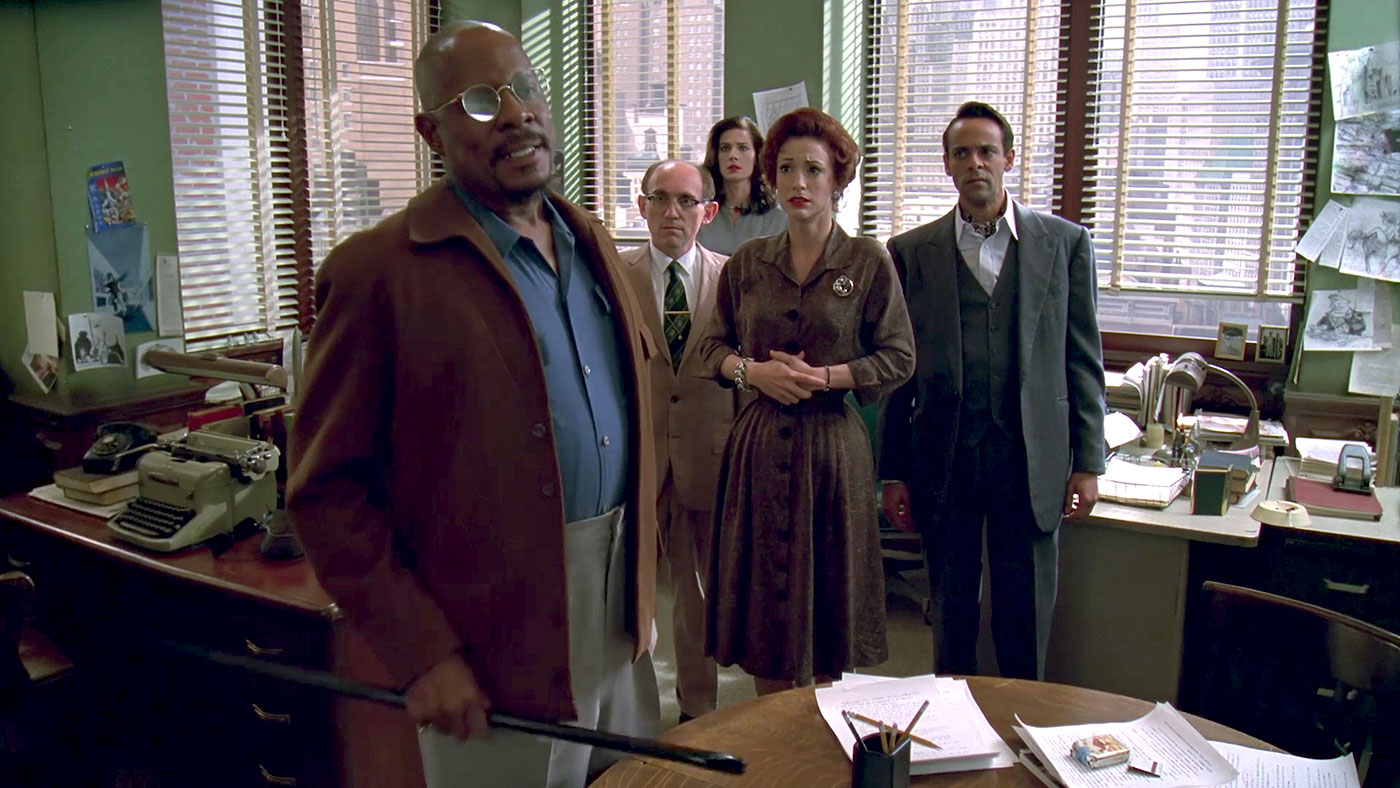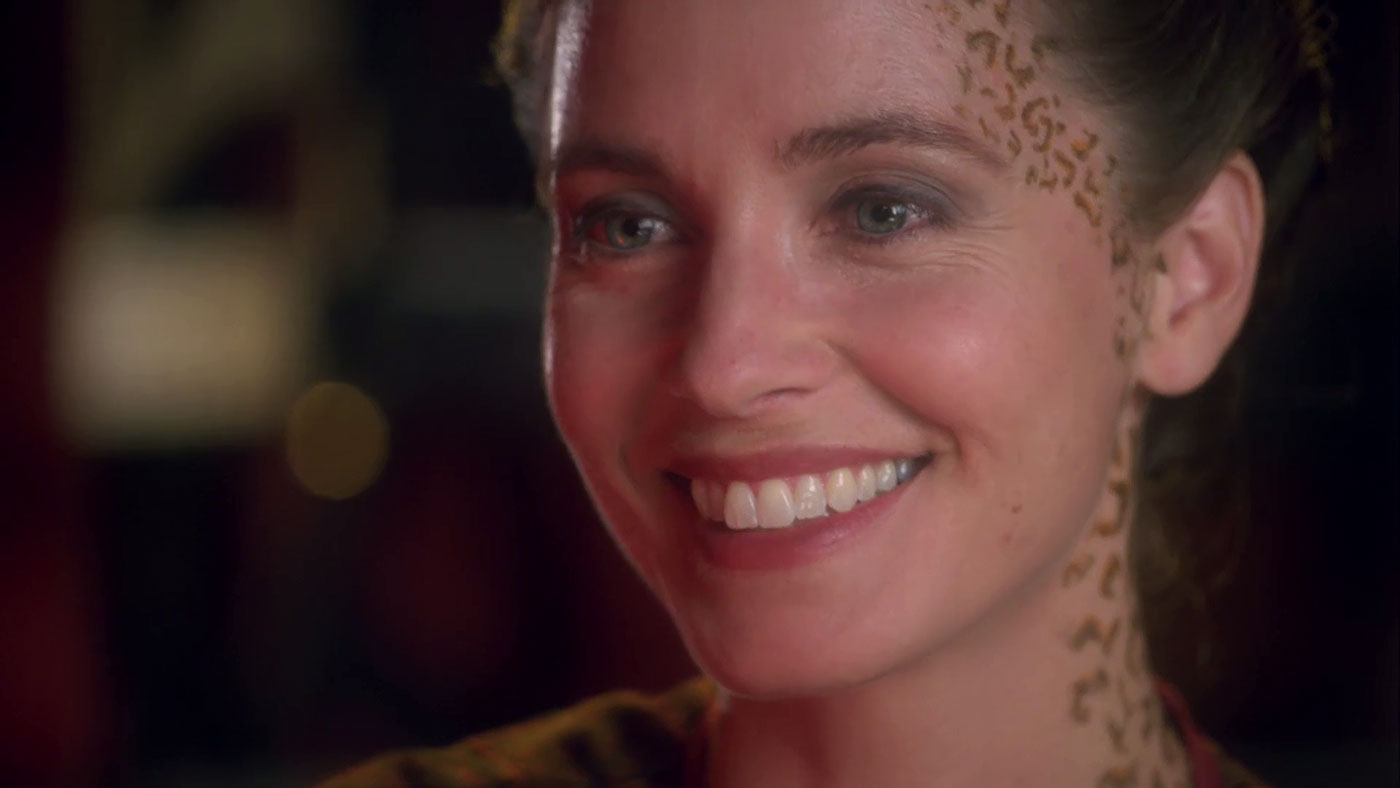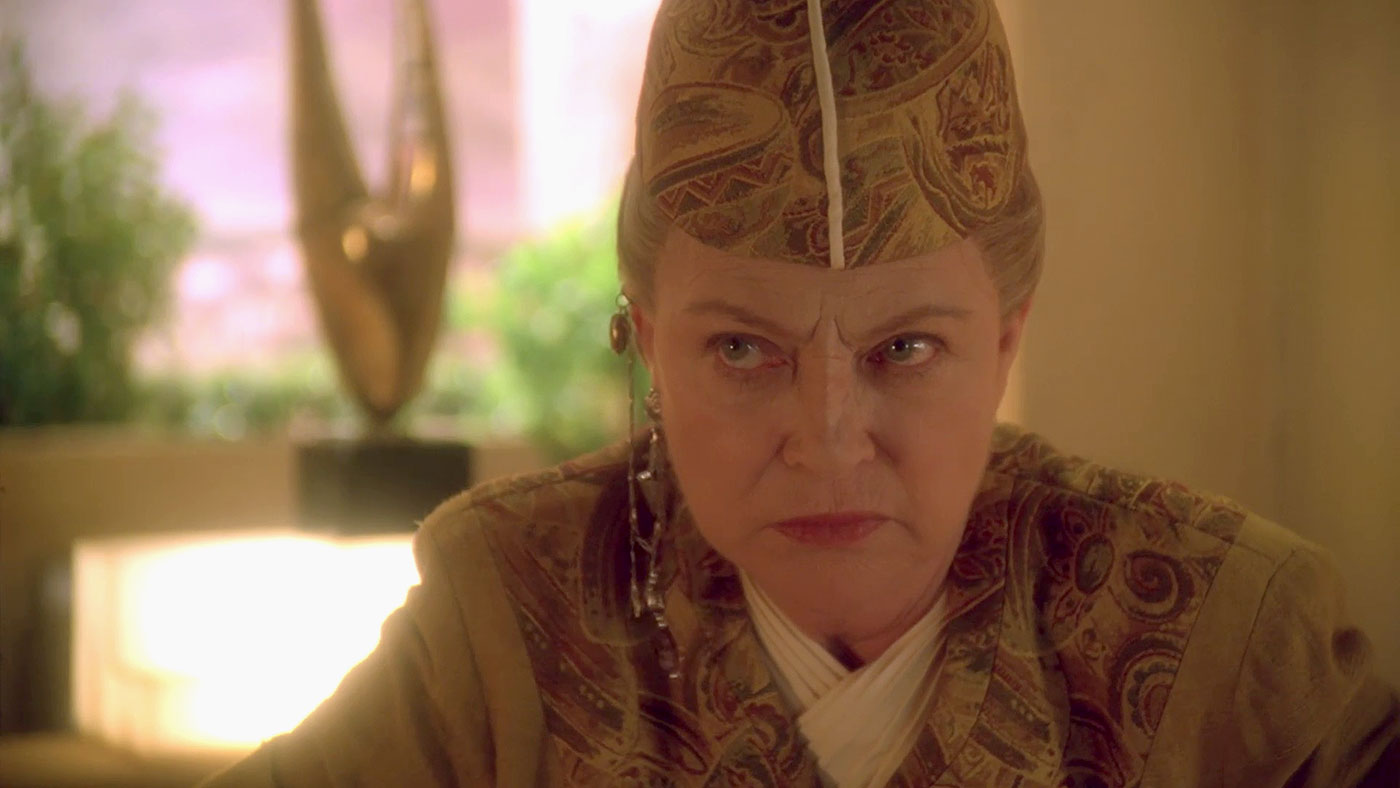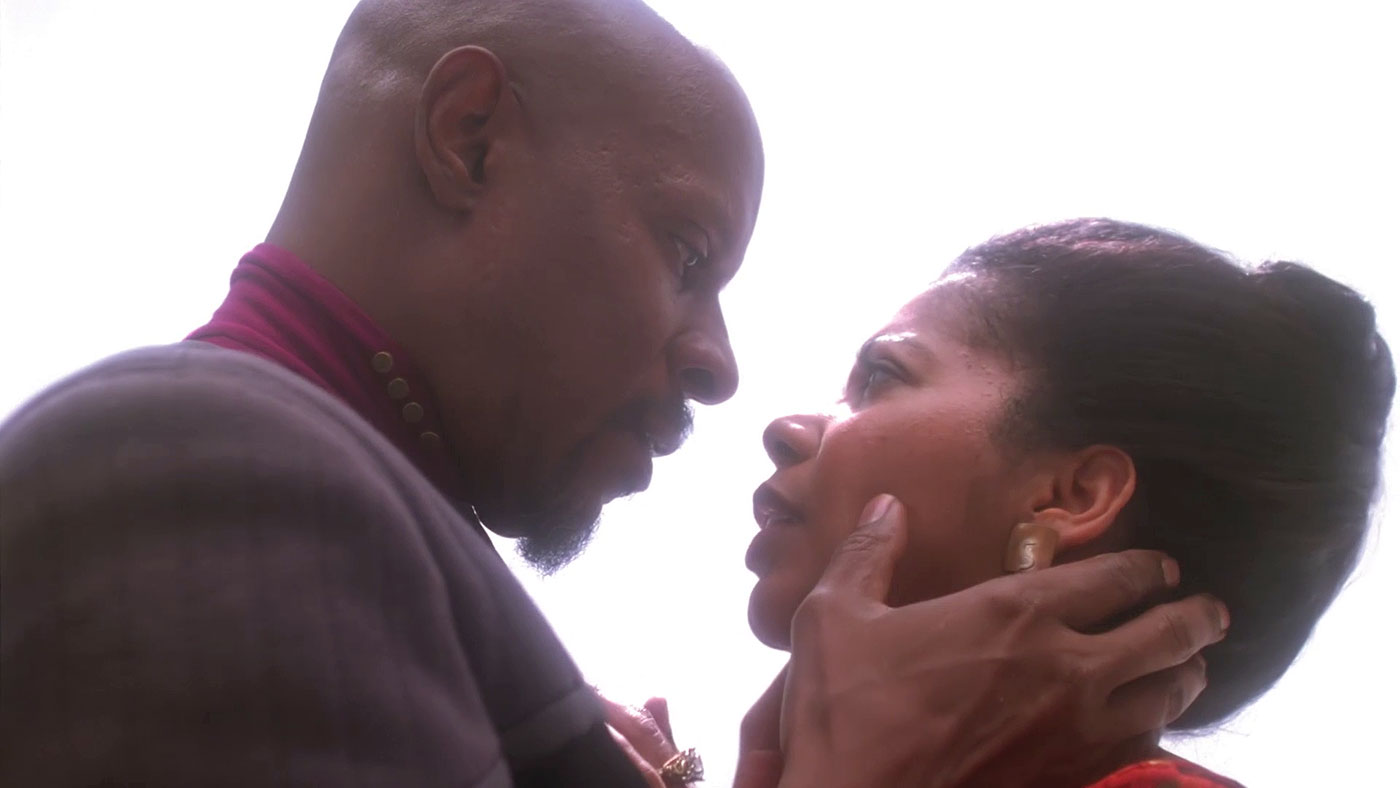About halfway through What We Left Behind, the years-in-the-making Star Trek: Deep Space Nine documentary, series showrunner Ira Steven Behr just can’t help himself, and he proudly bellows: “Guess what? This is Deep Space Nine. Don’t get too comfortable.”
It’s the perfect tagline for the documentary and the perfect summation of the franchise’s oft-misunderstood “middle child.” It’s the series that never aired alone. The series that executives never had as their main focus. The series that is now widely-hailed by fans as Trek‘s finest hour.
What We Left Behind is a spectacular piece of work that checks every possible box. It has candid and varied cast interviews, pointed conversations with series creatives and network executives, high-definition clips from some of the show’s greatest moments, and a fascinating look at a hypothetical “Season 8” and what might have been.

The entire endeavor is a masterclass in narrative storytelling, and every minute of the documentary is distinctively Ira Steven Behr. From the rotating bright colors on his prolific goatee to the dark nail polish on a single finger of each hand, the dynamic executive producer of Deep Space Nine is known for his counter-culture stylings — and he uses his brash, unapologetic view of the world in crafting this documentary in his own voice.
BEHR’S SINGULAR VOICE
The film is laced with his ironic, self-deprecating humor, jumping immediately into a series of vignettes with the cast reading 1993-era fan letters eviscerating the series and its boring premise and characters. The actors, like their executive producer, relish their “middle child” status in reading the spat of negative reactions from fans. And it’s incredibly funny.
Behr’s DNA can be felt all over the production in small moments like inside the “Season 8 writer’s room” feature — an ingenuous creative decision, weeded throughout documentary — where everyone is trying to pronounce and spell the Klingon home world, ultimately settling with an on-screen graphic that says: “Q’onos?”
Later we see a brilliant tit-for-tat argument between frequent series guest star Marc Alaimo (Gul Dukat) and Behr that is punctuated by a James Darren (Vic Fontaine) eyeroll. (Behr knows that nothing in this world is cooler than James Darren rolling his eyes at you.)
And at the mid-way point of the documentary, Behr answers a self-aware phone call from Andrew Robinson (Garak), who rips the writer a new one for killing off a beloved DS9 character in “Season 8,” and imploring him “to not hurt Julian” — all while punctuating the call by telling him he should have killed Worf instead!
All of these elements give the documentary a flair that compliments its creator in all the best ways. Curiously, where Behr’s style missed the mark was in the somewhat clumsy opening with Max Grodénchik crooning an original standard in full Vic Fontaine mode.
Everyone loves Grodénchik, the fan-favorite actor who portrayed Rom for seven years of the series, and there is nothing wrong with his performance, per se… but after a several-year wait for fans to see this documentary, it was a lackluster way to begin.
But it was also pure Behr – who then wisely doubled down on that opening by having Grodénchik return at the close of the film alongside Jeffrey Combs (Weyoun, et al), Casey Biggs (Damar) and Armin Shimerman (Quark) to sing “What We Left Behind,” an oft-heard standard performed by the actors on the convention circuit.
SEASON 8 WRITERS’ ROOM
Of course, the most unique aspect of the film is another Behr specialty – his construction of a “Season 8” writers’ room, where he brings together Deep Space Nine series vets Ronald D. Moore, René Echevarria, Hans Beimler and Robert Hewitt Wolfe to spend a day building the framework of a mythical season-opening episode of the show… set 20 years after “What You Leave Behind,” the 1999 series finale.
It’s amazing — and in no uncertain terms, you will leave the documentary feeling like you have just gotten a chance to revisit the Bajor sector. It’s fully satisfying and invigorating and will now be at the top of many fans’ Trek wish list — it’s just that good.
The animation accompanying the perfectly-paced Season 8 story is kinetic and exciting, with the story serving up thread after gratifying thread of “where they are now” nuggets. It would be hard to overstate how much fun it is to watch these writers apply their craft, and even though there is a lot here, we know there will be a lot more of it to watch once the Blu-ray extras are released.
HOLDING THEMSELVES ACCOUNTABLE
Of course, the story being told in What We Left Behind is not all fun and games.
Throughout the film, Behr continually holds himself and his series accountable in ways that most creators might be afraid to. While lauding the series’ impressive accomplishments in addressing major social issues of the time (the cost of war, homelessness, religion), he refuses to give himself a passing grade in the area of sexual identity.

Yes, the series produced the standout episode “Rejoined,” which is rightly hailed for showing two people loving each other regardless of their shifting personal identities, but as Behr says, “One episode in seven years? We could have done better, trust me. We should have done better.” He even goes on to pinpoint what he deems as the “obvious” missed opportunity of making Garak gay. But would the studio have allowed such a thing? “Probably not, but we never asked. That’s we don’t get that [credit].”
This is what Behr does so well — and why Deep Space Nine is such a brilliant series. He’s always in the moment, and always immediately reflective on why they are making the decisions they are making. With that in mind, he sets aside the time to highlight his beloved mentor, the late Michael Piller, at a couple of points in the documentary, remembering him as a man that believed “plot only existed to explain and reveal character.”
“It’s all about revealing the character for who they really are,” said Behr, paraphrasing Piller. “To go deep beneath the surface of the character and reveal them in a way that the audience had never thought of or never expected or just didn’t know.” Behr clearly learned from the best, and it’s evident throughout the film.

The filmmakers also find the time to examine the studio’s role in many of the battles they faced through the years. Kerry McCluggage, the former chairman of the Paramount Television Group, seems to be aware that his role in the film is not a particularly positive one. The dapperly-attired executive works hard to choose his words as delicately as possible, and he is not entirely successful when discussing the executive level decision to not allow series lead Avery Brooks (Ben Sisko) to shave his head — or sport a goatee — until three years into the show.
“I do think going in, uh, particularly given that he was coming off of Hawk and we were also in the 24th century,” said McCluggage, “that we thought it would be a mistake, to, uh, to, to go, uh, for the lack of a better term, ‘street.’”
Yikes, right? This is just another place where Behr and his co-producers don’t pull any punches, painting a pretty clear picture of the racial overtones they needed to overcome at the executive level to fully realize their vision.
GLORIOUS HIGH DEFINITION
And in crafting this documentary, the filmmakers overcame another monumental challenge, this one on the technical side of things. Instead of taking the easy way out (as if that was something this crew would ever do), the production arm found a way to remaster virtually the entire film in glorious HD. The scores of amazing episode clips laced throughout the film allow the viewer to experience the series in a completely new way, as we addressed in our recent featured article.
The task of bringing the film to HD was no small burden, and became the main reason the documentary took almost three years to release after the first fundraiser kicked off in 2016. The extra production effort and campaigning done by Behr and his lead producers, David Zappone (who co-directed the film with Behr) and Kai de Mello-Folsom, to acquire the time and resources necessary to make sure the film was seen in high definition has been well documented.

Sequences like Dukat and Kira’s desert hike in “Indiscretion,” Sisko and Bashir’s stroll through 2024’s San Francisco ‘Sanctuary District’ in “Past Tense,” and Odo’s flashback to the dark and smoky Terok Nor (“Things Past”) are some of the highlights of the restored footage — and while some shots mixing live-action and visual effects elements are simply upscaled from the original standard-def presentation, some brand-new high-def visual effects included in certain scenes are eye-poppingly stunning.
ONE TOPIC TO THE NEXT
Ultimately, What We Left Behind is impressive for the way it controls the narrative flow, hitting on scores of topics as they seamlessly flow one into another into another.
The section on Sisko transforms into Terry Farrell discussing the ways in which she was able to discover Jadzia Dax’s character beneath Brooks’ shadow. A conversation about Quark and Odo’s verbal sparring flowed into an analysis of Odo and Kira’s relationship, and then into a discussion with Visitor and the ramifications of playing a terrorist on television before 9/11. That segment then moved into a piece about Dukat pursuing Kira romantically, which led to Visitor challenging Behr for even thinking about consummating their relationship.
From there segments on Garak, James Darren, Nog and story arcs, touched on multiple members of the regular guest cast (Biggs as Damar, Chase Masterson as Leeta and Grodénchik as Rom), culminating with a shout-out to Jeffrey Combs and his amazing array of Trek characters.
The addition of Worf in Season 4 quickly evolves into a segment on his relationship with Dax and the emotional departure of Farrell from the show. The disbelief from writers Ronald D. Moore and Rene Echeverria that Farrell would ever be allowed to leave is palpable, and Farrell herself is emotionally raw discussing her decision to not come back for a seventh season, highlighting a conversation with an executive in which he dismissed her by saying “she’d be working at K-Mart” if not for this show.
Other topics in the documentary include Herman Zimmerman’s production design, the evolution of Julian Bashir (everyone hated him early on), and the birth of the Dominion and the creation of the Defiant.
The film also highlights Brooks’ superb direction of “Far Beyond the Stars” and the portrayal of the African-American family dynamic at the front and center of a 1990s-era television show, with an obvious focus on the relationship between Sisko and Jake (Cirroc Lofton).
STAY FOR THE CREDITS
It’s those closing credits, though, that might just be the highlight of the film. They are classic Ira Steven Behr; turning the expectations and disappointments of the viewer against themselves, by slyly detailing everything they know the audience is currently bitching about. It’s a masterstroke. And it’s satisfying in a way that is hard to describe, other than to say you never want it to end.
https://www.youtube.com/watch?v=Vz0tUnMqFy8
In five minutes of scrolling credits, Behr and Nana Visitor (Kira) banter back and forth about 12 additional topics that got short-shrift in the documentary, because, as Behr points out, “We had to make difficult choices — otherwise this film would be eight hours long, at least.”
Accompanied by a pitch-perfect rock ’n’ roll version of Dennis McCarthy’s DS9 theme by the popular Star Trek band Five Year Mission, the topics discussed in the credits include fan-favorite episodes like “Trials and Tribble-ations” and “The Visitor,” the Bashir-O’Brien friendship, the crew’s frequent encounter with the Mirror Universe, and many other series highlights that we’ll hopefully see in the to-be-announced Blu-ray release of the film.
And if all of that wasn’t enough, stick around to the very end, where you’ll be treated to one of the greatest moments from all of Deep Space Nine… featuring a plain, simple tailor that some of you may remember.

In the end, What We Left Behind is now the definitive Star Trek documentary in terms of pure quality. It doesn’t have the tinny, made-for-television feel that has permeated so many of the fine Trek documentaries that have preceded it. It’s a comprehensive evaluation of itself (both good and bad) as a transformative series and its place in both Star Trek history and television history — and an absolute must-see for Deep Space Nine fans everywhere.
Jim Moorhouse is the creator of TrekRanks.com and the TrekRanks Podcast.
He can be found living and breathing Trek every day on Twitter at @EnterpriseExtra.
![]()
What We Left Behind: A Look Back at ‘Star Trek: Deep Space Nine’ arrives in theaters for a one-night only screening on May 13 in the United States via Fathom Events, and will play for a limited run in Canada starting the same day through Cineplex.
Plans for additional home-media release options, including streaming and DVD/Blu-ray releases, are in the works but specific details have not yet been announced.
